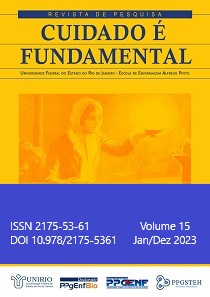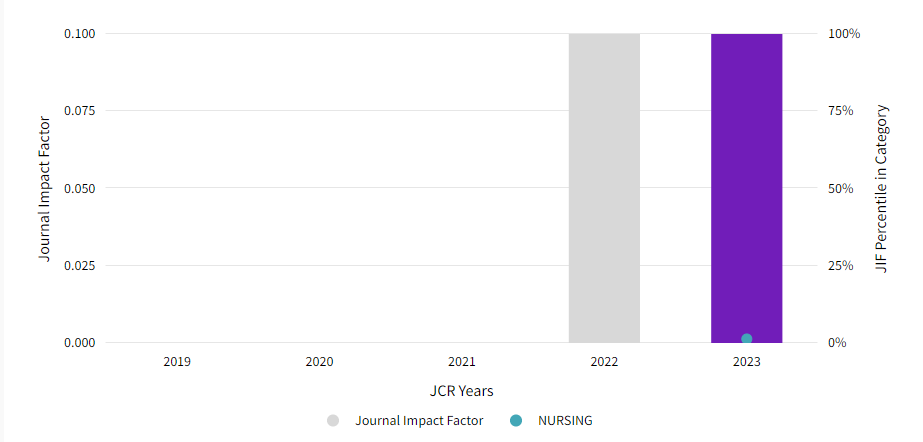Factors associated with emergency room visit or hospitalization in care oncology home care: an integrative review /Fatores associados à visita à emergência ou hospitalização em cuidados paliativos oncológicos domiciliares: uma revisão integrativa
DOI:
https://doi.org/10.9789/2175-5361.rpcfo.v15.12000Keywords:
Palliative care, Neoplasms, Home care services, Emergency, HospitalizationAbstract
Objective: to identify the factors associated with the emergency visit or hospitalization of cancer patients in palliative home care. Method: integrative review in PubMed, LILACS, Web of Science and Embase. The question was “what factors are associated with visiting emergency services or hospitalization of cancer patients in palliative home care?”. Descriptors were neoplasms; palliative care; hospitalization; emergency medical services; home care services. Eligibility criteria were full text; between 2012 and 2022; English, Portuguese or Spanish language; adulthood. Results: 16 articles were selected. The most common causes of emergency room visits/hospitalization were pain, shortness of breath, infection, digestive symptoms, delirium, and poor general condition/fatigue. Conclusion: This study identified gaps in which palliative home care can be improved.
Downloads
References
World Health Organization (WHO). WHO Cancer Resolution; Cancer prevention and control in the context of an integrated approach. 17th World Heal Assem. [Internet]. 2017 [cited 2022 sep 5]. Available from: https://apps.who.int/iris/handle/10665/275676.
Worldwide Hospice Palliative Care Alliance (WHPCA) [homepage in internet]. Global Atlas of Palliative Care. 2nd Edition. 2020 [cited 2022 sep 5]. Available from: https://www.thewhpca.org/resources/global-atlas-on-end-of-life-care.
Atty AT de M, Tomazelli JG. Cuidados paliativos na atenção domiciliar para pacientes oncológicos no Brasil. Saúde debate. [Internet]. 2018 [acesso em 05 de setembro 2022];42(116). Disponível em: https://doi.org/10.1590/0103-1104201811618.
Bittencourt NCC de M, Santos KA, Mesquita MG da R, Silva VG da, Telles AC, Silva MM da. Sinais e sintomas manifestados por pacientes em cuidados paliativos oncológicos na assistência domiciliar: uma revisão integrativa. Esc. Anna Nery Rev. Enferm. [Internet]. 2021 [acesso em 05 de setembro 2022];25(4). Disponível em: https://doi.org/10.1590/2177-9465-EAN-2020-0520.
OhioHealth Hospice. Vamos falar de Cuidados Paliativos. Soc Bras Geriatr e Gerontol. [Internet]. 2014 [acesso em 05 de setembro 2022];17. Disponível em: https://sbgg.org.br/wp-content/uploads/2014/11/vamos-falar-de-cuidados-paliativos-vers--o-online.pdf.
Mercadante S, Masedu F, Valenti M, Mercadante A, Aielli F. The characteristics of advanced cancer patients followed at home but admitted to the hospital for the last days of life. Intern. emerg. med. [Internet]. 2016 [cited 2022 sep 5];11(5). Available from: https://doi.org/10.1007/s11739-016-1402-1.
Moncho MEI, Palomar-Abril V, Soria-Comes T. Palliative Care Unit at Home: Impact on Quality of Life in Cancer Patients at the End of Life in a Rural Environment. Am J Hosp Palliat Med. [Internet]. 2022 [cited 2022 sep 5];39(5). Available from: https://doi.org/10.1177/10499091211038303.
Dhiliwal SR, Muckaden M. Impact of specialist home-based palliative care services in a tertiary oncology set up: A prospective non-randomized observational study. Indian J Palliat Care. [Internet]. 2015 [cited 2022 sep 5];21(1). Available from: https://doi.org/10.4103/0973-1075.150170.
Riolfi M, Buja A, Zanardo C, Marangon CF, Manno P, Baldo V. Effectiveness of palliative home-care services in reducing hospital admissions and determinants of hospitalization for terminally ill patients followed up by a palliative homecare team: A retrospective cohort study. Palliat. med. [Internet]. 2014 [cited 2022 sep 5];28(5). Available from: https://doi.org/10.1177/0269216313517283.
Enguidanos S, Rahman A, Fields T, Mack W, Brumley R, Rabow M, et al. Expanding access to home-based palliative care: A randomized controlled trial protocol. J. palliat. med. [Internet]. 2019 [cited 2022 sep 5];22(S1). Available from: https://doi.org/10.1089/jpm.2019.0147.
Sutradhar R, Barbera L, Seow HY. Palliative homecare is associated with reduced high- and low-acuity emergency department visits at the end of life: A population-based cohort study of cancer decedents. Palliat. med. [Internet]. 2017 [cited 2022 sep 5];31(5). Available from: https://doi.org/10.1177/0269216316663508.
Alonso-Babarro A, Astray-Mochales J, Domínguez-Berjón F, Gènova-Maleras R, Bruera E, Díaz-Mayordomo A, et al. The association between in-patient death, utilization of hospital resources and availability of palliative home care for cancer patients. Palliat. med. [Internet]. 2013 [cited 2022 sep 5];27(1). Available from: https://doi.org/10.1177/0269216312442973.
Mracek J, Earp M, Sinnarajah A. Palliative home care and emergency department visits in the last 30 and 90 days of life: A retrospective cohort study of patients with cancer. BMJ support. palliat. care (Online). 2021 [cited 2022 sep 5];(1):1–10. Available from: https://doi.org/10.1136/bmjspcare-2021-002889.
Chitnis XA, Georghiou T, Steventon A, Bardsley MJ. Effect of a home-based end-of-life nursing service on hospital use at the end of life and place of death: A study using administrative data and matched controls. BMJ support. palliat. care (Online). [Internet]. 2013 [cited 2022 sep 5];3(4). Available from: https://doi.org/10.1136/bmjspcare-2012-000424.
Miranda B, Vidal SA, De Mello MJG, De Lima JTO, Rêgo JC, Pantaleão MC, et al. Cancer patients, emergencies service and provision of palliative care. Rev. Assoc. Med. Bras. (1954). [Internet]. 2016 [cited 2022 sep 5];62(3). Available from: https://doi.org/10.1590/1806-9282.62.03.207.
Seow H, Barbera L, Sutradhar R, Howell D, Dudgeon D, Atzema C, et al. Trajectory of performance status and symptom scores for patients with cancer during the last six months of life. J. clin. oncol. [Internet]. 2011 [cited 2022 sep 5];29(9). Available from: https://doi.org/10.1200/jco.2010.30.7173.
Barbera L, Taylor C, Dudgeon D. Why do patients with cancer visit the emergency department near the end of life? Cmaj. [Internet]. 2010 [cited 2022 sep 5];182(6). Available from: https://doi.org/10.1503/cmaj.091187
Seow H, Barbera L, Pataky R, Lawson B, O’Leary E, Fassbender K, et al. Does Increasing Home Care Nursing Reduce Emergency Department Visits at the End of Life? A Population-Based Cohort Study of Cancer Decedents. J. pain symptom manage. [Internet]. 2016 [cited 2022 jan 01];51(2). Available from: http://dx.doi.org/10.1016/j.jpainsymman.2015.10.008.
Verhoef MJ, de Nijs E, Horeweg N, Fogteloo J, Heringhaus C, Jochems A, et al. Palliative care needs of advanced cancer patients in the emergency department at the end of life: an observational cohort study. Support. care cancer. [Internet]. 2020 [Cited 2022 sep 5];28(3). Available from: https://doi.org/10.1007/s00520-019-04906-x.
Earle CC, Neville BA, Landrum MB, Ayanian JZ, Block SD, Weeks JC. Trends in the aggressiveness of cancer care near the end of life. J. clin. oncol. [Internet].
[cited 2022 sep 5];22(2). Available from: https://doi.org/10.1200/jco.2004.08.136.
Earle CC, Neville BA, Landrum MB, Souza JM, Weeks JC, Block SD, et al. Evaluating claims-based indicators of the intensity of end-of-life cancer care. Int J Qual Heal Care. [Internet]. 2005 [cited 2022 sep 5];17(6). Available from: https://doi.org/10.1093/intqhc/mzi061.
Soares LGL, Gomes R V., Palma A, Japiassu AM. Quality Indicators of End-ofLife Care Among Privately Insured People With Cancer in Brazil. Am J Hosp Palliat Med. [Internet]. 2020 [cited 2022 sep 5];37(8). Available from: https://doi.org/10.1177/1049909119888180.
Henson LA, Gomes B, Koffman J, Daveson BA, Higginson IJ, Gao W. Factors associated with aggressive end of life cancer care. Support. care cancer. [Internet]. 2016 [cited 2022 sep 5];24(3). Available from: https://doi.org/10.1007/s00520-015-2885-4.
Andersen SK, Croxford R, Earle CC, Singh S, Cheung MC. Days at home in the last 6 months of life: A patient-determined quality indicator for cancer care. J. oncol. pharm. pract. (Online). [Internet]. 2019 [cited 2022 sep 5];15(7). Available from: https://doi.org/10.1200/jop.18.00338.
Mendes K, Silveira R, Galvão C. Revisão integrativa: método de pesquisa para a incorporação de evidências na saúde e na enfermagem. Texto & contexto enferm. [Internet]. 2008 [acesso em 05 de setembro 2022];17(4). Disponível em: https://doi.org/10.1590/S0104-07072008000400018.
Heinonen T, Loimu V, Saarilahti K, Saarto T, Mäkitie A. End-of-life care pathway of head and neck cancer patients: single-institution experience. Eur Arch Oto-Rhino-Laryngology. [Internet]. 2018 [cited 2022 jan 01];275(2). Available from: http://dx.doi.org/10.1007/s00405-017-4843-x.
Hsu HS, Wu TH, Lin CY, Lin CC, Chen TP, Lin WY. Enhanced home palliative care could reduce emergency department visits due to non-organic dyspnea among cancer patients: a retrospective cohort study. BMC palliat. care. [Internet]. 2021 [cited 2022 sep 5];20(1). Available from: https://doi.org/10.1186/s12904-021-00713-6.
Seow H, Sutradhar R, McGrail K, Fassbender K, Pataky R, Lawson B, et al. Endof-Life Cancer Care: Temporal Association between Homecare Nursing and Hospitalizations. J. palliat. med. [Internet]. 2016 [cited 2022 sep 5];19(3). Available from: https://doi.org/10.1089/jpm.2015.0229.
Mercadante S, Adil C, Caruselli A, Ferrera P, Costanzi A, Marchetti P, et al. The palliative-supportive care unit in a comprehensive cancer center as crossroad for patients’ oncological pathway. PLos ONE. [Internet]. 2016 [cited 202 sep 5];11(6). Available from: https://doi.org/10.1371/journal.pone.0157300.
Hjermstad MJ, Kolflaath J, Løkken AO, Hanssen SB, Normann AP, Aass N. Are emergency admissions in palliative cancer care always necessary? Results from a descriptive study. BMJ Open. [Internet]. 2013 [cited 2022 sep 5];3(5):e002515. Available from: https://doi.org/10.1136/bmjopen-2012-002515.
Kao YH, Liu YT, Koo M, Chiang JK. Factors associated with emergency services use in Taiwanese advanced cancer patients receiving palliative home care services during out-of-hours periods: A retrospective medical record study. BMC palliat. care. [Internet]. 2018 [cited 2022 sep 5];17(1). Available from: https://doi.org/10.1186/s12904-018-0302-8.
Gamblin V, Prod’homme C, Lecoeuvre A, Bimbai AM, Luu J, Hazard PA, et al. Home hospitalization for palliative cancer care: factors associated with unplanned hospital admissions and death in hospital. BMC palliat. care. [Internet]. 2021 [cited 2022 sep 5];20(1). Available from: https://doi.org/10.1186/s12904-021-00720-7.
Cornillon P, Loiseau S, Aublet-Cuvelier B, Guastella V. Reasons for transferral to emergency departments of terminally ill patients - A French descriptive and retrospective study. BMC palliat. Care. [Internet]. 2016 [cited 2022 jan 01];15(1). Available from: http://dx.doi.org/10.1186/s12904-016-0155-y.
De Korte-Verhoef MC, Pasman HRW, Schweitzer BP, Francke AL, OnwuteakaPhilipsen BD, Deliens L. End-of-life hospital referrals by out-of-hours general practitioners: A retrospective chart study. BMC fam. pract. [Internet]. 2012 [cited 2022 sep 5];13. Available from: https://doi.org/10.1186/1471-2296-13-89.
Salam-White L, Hirdes JP, Poss JW, Blums J. Predictors of emergency room visits or acute hospital admissions prior to death among hospice palliative care clients in Ontario: A retrospective cohort study. BMC palliat. care. [Internet]. 2014 [cited 2022 sep 5];13(1). Available from: https://doi.org/10.1186/1472-684x-13-35.
Gomes B, Higginson IJ. Factors influencing death at home in terminally ill patients with cancer: Systematic review. Br. med. j. [Internet]. 2006 [cited 2022 sep 5];332(7540). Available from: https://doi.org/10.1136/bmj.38740.614954.55.
Hennemann-Krause L, Lopes AJ, Araújo JA, Petersen EM, Nunes RA. The assessment of telemedicine to support outpatient palliative care in advanced cancer. Palliat. support care. [Internet]. 2015 [cited 2022 sep 5];13(4). Available from: https://doi.org/10.1017/s147895151400100x.
Silva VG da, Telles AC, Guimarães N de PA, Souza FN de, Campo LL, Bittencourt NCC de M, et al. A propulsão do teleatendimento no cuidado paliativo oncológico domiciliar durante a pandemia de COVID-19. Res Soc Dev. [Internet]. 2022 [acesso em 05 de setembro 2022];11(5):e35711528300. Disponível em: http://dx.doi.org/10.33448/rsd-v11i5.28300.
Mercadante S, Porzio G, Valle A, Aielli F, Costanzo V, Adile C, et al. Emergencies in patients with advanced cancer followed at home. J. pain symptom manage. [Internet]. 2012 [cited 2022 jan 01];44(2). Available from: http://dx.doi.org/10.1016/j.jpainsymman.2011.07.016.
Published
Versions
- 2024-10-29 (3)
- 2023-06-30 (2)
- 2023-04-11 (1)
How to Cite
Issue
Section
License
Copyright (c) 2023 Revista de Pesquisa Cuidado é Fundamental Online

This work is licensed under a Creative Commons Attribution-NonCommercial-NoDerivatives 4.0 International License.
TRANSFER AGREEMENT COPYRIGHT I transfer copyright of the article to the Journal of Care Survey is Fundamental - Online - RPCF, so it is accepted due to electronic publishing. The copyright includes the right to reproduce in whole or in part by any means, distributing that article, including figures, photographs, and any translations. The author can also print and distribute copies of your article, stating that since the rights belong to RPCF. I declare that this manuscript is original and has not been submitted for publication, in whole or in part to other online journals or not, so BMMC in the Annals of scientific events or book chapters.




























